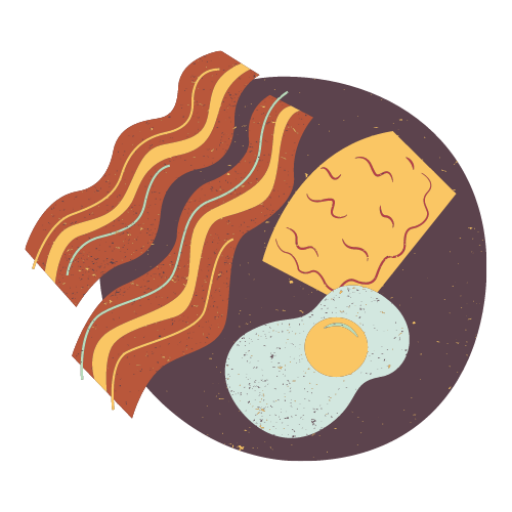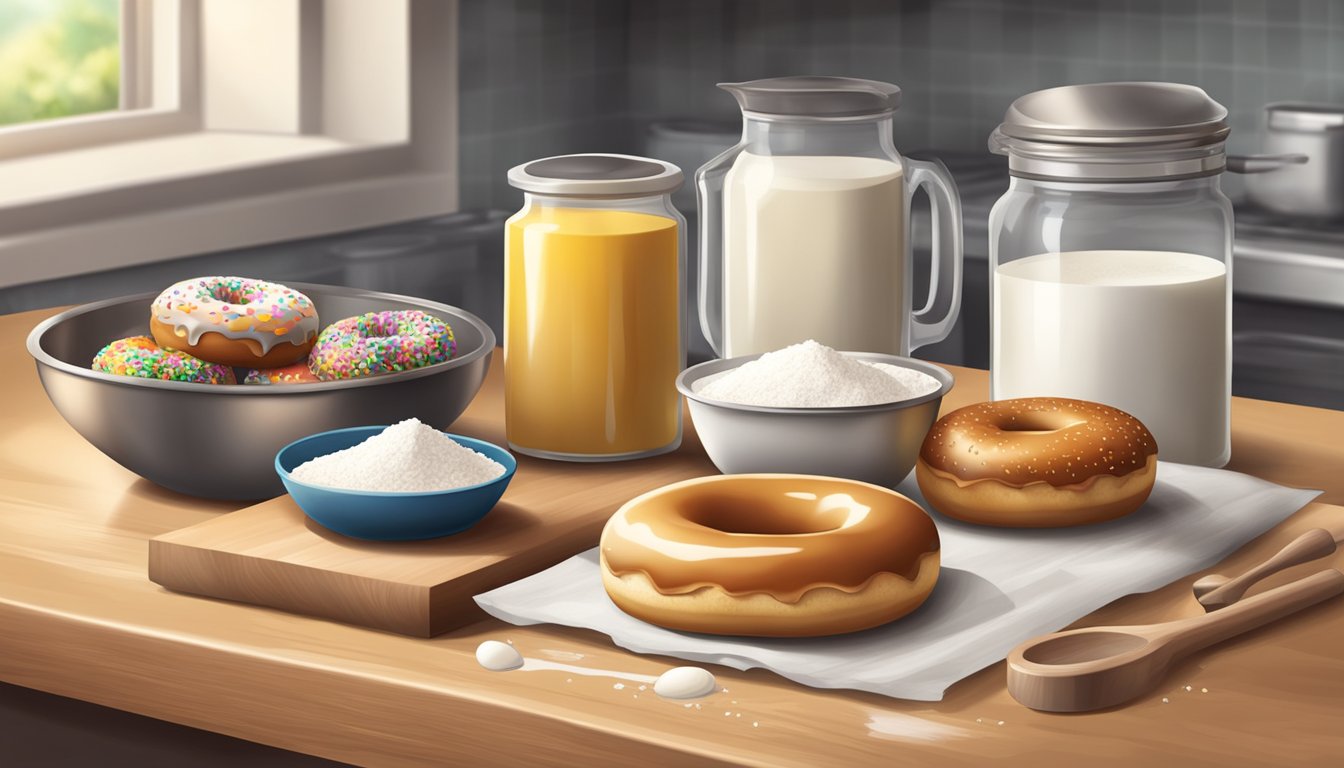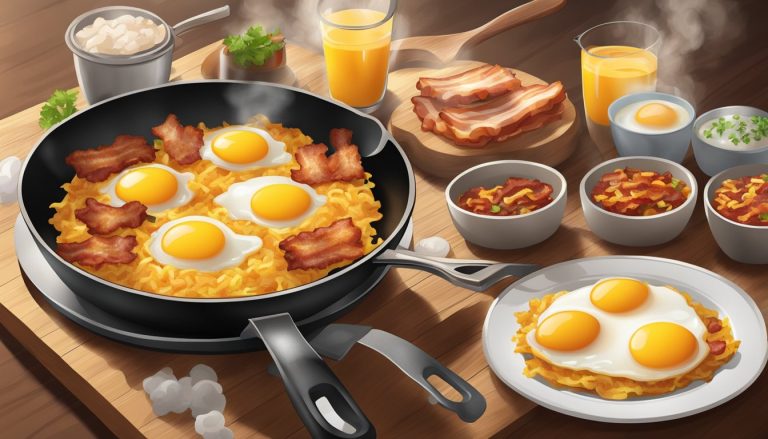Homemade breakfast donuts are a delightful way to start the day. These sweet, pillowy treats can be customized with various glazes and toppings to suit any taste preference. Making donuts at home is simpler than many people realize, requiring basic ingredients like flour, yeast, milk, eggs, and butter.
The process involves creating a yeast dough, allowing it to rise, shaping the donuts, and frying them to golden perfection. While it takes some time for the dough to rise, the active preparation and cooking time is relatively short. This makes homemade donuts a feasible option for weekend breakfasts or special occasions.
Homemade donuts offer the advantage of freshness and control over ingredients. They can be made healthier by using whole wheat flour or baking instead of frying. For those who enjoy a hands-on culinary experience, making donuts from scratch can be a fun and rewarding breakfast activity.
Understanding Donut Ingredients
Donut ingredients play a crucial role in creating the perfect texture, flavor, and appearance. Each component serves a specific purpose in the dough-making process and final product.
Flour Choices
All-purpose flour is the most common choice for homemade donuts. It provides a good balance of protein content, resulting in a tender yet sturdy texture. For a lighter crumb, cake flour can be used.
Bread flour, with its higher protein content, creates chewier donuts. Some recipes call for a blend of different flours to achieve the desired texture.
Measuring flour correctly is essential. Use the spoon-and-level method for accuracy, as too much flour can lead to dense donuts.
Yeast Explained
Yeast is the leavening agent responsible for the rise in yeast-based donuts. Active dry yeast and instant yeast are the two main types used in donut recipes.
Active dry yeast requires proofing in warm liquid before use. Instant yeast can be mixed directly with dry ingredients.
Proper activation of yeast is crucial. The liquid used should be around 110°F (43°C) to ensure optimal yeast activity without killing the organisms.
Liquids for Donut Dough
Whole milk is often the primary liquid in donut recipes. It adds richness and helps create a tender crumb.
Water can be used for a lighter texture. Some recipes incorporate buttermilk for tang and tenderness.
Eggs contribute moisture, structure, and richness to the dough. They also help bind ingredients together.
The Sweetness Factor
Sugar serves multiple purposes in donut recipes. It provides sweetness, contributes to browning, and helps retain moisture.
Granulated sugar is most common, but some recipes use brown sugar for added flavor depth.
The amount of sugar affects not only sweetness but also texture. Too much can lead to a denser donut.
Enriching Additions
Butter adds richness and flavor to donuts. It also contributes to a tender crumb and helps create a golden-brown exterior.
Vegetable oil is sometimes used in place of butter. It keeps donuts moist and tender for longer periods.
Salt enhances flavors and balances sweetness. It also strengthens gluten structure in the dough.
Vanilla extract is a common flavoring that complements the sweetness of donuts. Other extracts or spices can be used for variety.
Preparation Basics
Mastering the essentials of donut preparation sets the foundation for delicious homemade breakfast treats. The process involves several key steps, from creating the perfect dough to deciding between frying and baking methods.
Creating the Dough
Start by gathering high-quality ingredients for your donut dough. Combine flour, sugar, yeast, and salt in a large mixing bowl. In a separate container, whisk together warm milk, melted butter, and eggs.
Gradually incorporate the wet ingredients into the dry mixture. Knead the dough until it becomes smooth and elastic. This process typically takes 8-10 minutes by hand or 5-7 minutes using a stand mixer with a dough hook attachment.
Once the dough reaches the right consistency, form it into a ball. Place it in a greased bowl, cover with plastic wrap, and let it rest in a warm area.
The Rising Process
Proper rising is crucial for achieving light and fluffy donuts. Allow the dough to rise in a warm, draft-free environment for about 1-2 hours, or until it doubles in size.
After the initial rise, gently punch down the dough to release air bubbles. Turn it out onto a lightly floured surface and roll it to about 1/2 inch thickness.
For best results, let the shaped donuts rise again for 30-45 minutes before cooking. This second rise enhances texture and flavor.
Shaping Donuts
Use a donut cutter or two round cookie cutters (one larger, one smaller) to cut out the classic donut shape. A 3-3.5 inch cutter works well for the outer circle, with a 1-inch cutter for the center hole.
If you don’t have a specific donut cutter, a wide-mouth mason jar lid and a bottle cap can serve as makeshift cutters. Alternatively, use a biscuit cutter for round, hole-less donuts.
Place the shaped donuts on lightly greased baking sheets, leaving space between each one. Don’t discard the donut holes – they make excellent bite-sized treats!
Frying vs. Baking
Decide between frying and baking based on your preference for texture and health considerations. Fried donuts offer a classic crispy exterior with a soft interior. Heat oil to 350°F (175°C) and fry for 1-2 minutes per side until golden brown.
For a healthier option, bake donuts at 350°F (175°C) for 10-12 minutes. Baked donuts have a cake-like texture and require less oil. Use a specialized donut pan for uniform shapes when baking.
Both methods produce delicious results. Experiment to find your preferred cooking technique. Remember to let donuts cool slightly before glazing or dusting with sugar.
Cooking Techniques
Mastering the art of cooking homemade breakfast donuts involves several key techniques. Each method offers unique textures and flavors, while proper temperature control ensures perfect results every time.
Deep Frying Donuts
Deep frying is the classic technique for achieving golden, crispy donuts. Fill a deep fryer or heavy-bottomed pot with canola oil, heating it to 350°F-375°F. Use a candy thermometer to monitor the oil temperature accurately.
Carefully lower the donuts into the hot oil using tongs. Fry for 1-2 minutes per side until golden brown. Avoid overcrowding the pot to maintain consistent oil temperature.
Remove the donuts with a slotted spoon or tongs, allowing excess oil to drip off. Place them on a cooling rack lined with paper towels to absorb any remaining oil.
Baking in the Oven
Baked donuts offer a healthier alternative to deep-fried versions. Preheat the oven to 350°F. Grease donut pans with non-stick cooking spray or butter.
Fill the pans with batter, leaving some space for expansion. Bake for 10-12 minutes, or until the donuts are lightly golden and spring back when touched.
Allow the donuts to cool in the pan for a few minutes before transferring to a cooling rack. This prevents them from becoming soggy.
Monitoring Donut Temperature
Proper temperature control is crucial for perfectly cooked donuts. For deep frying, maintain oil temperature between 350°F-375°F. Lower temperatures result in greasy donuts, while higher temperatures cause burnt exteriors and raw interiors.
Use a candy thermometer to check oil temperature regularly. Adjust heat as needed to maintain consistency. Allow oil to reheat between batches.
For baked donuts, ensure the oven is fully preheated before baking. Use an oven thermometer to verify accuracy. Check donuts for doneness by inserting a toothpick into the center – it should come out clean when ready.
Creating Glazes and Toppings
Glazes and toppings elevate homemade donuts from simple treats to irresistible delights. A well-crafted glaze adds sweetness and shine, while creative toppings provide texture and visual appeal.
Simple Sugar Glaze
A basic sugar glaze forms the foundation for many donut variations. Mix 2 cups of powdered sugar with 1/4 cup of milk and 1 teaspoon of vanilla extract. Whisk until smooth, adjusting consistency with more milk or sugar as needed.
For a thinner glaze, add milk gradually. To thicken, incorporate additional powdered sugar. Dip cooled donuts into the glaze, allowing excess to drip off before placing on a wire rack to set.
Flavored Glazes
Experiment with flavored glazes to create unique donut varieties. For a maple glaze, replace vanilla with maple syrup. Chocolate glaze combines cocoa powder with the basic sugar glaze recipe.
Fruit-flavored glazes incorporate jam or fruit puree. Mix 1/4 cup of strained jam with 1 cup of powdered sugar and a splash of milk. Adjust thickness as needed.
For a tangy twist, add citrus zest or juice to the basic glaze recipe. Lemon, orange, or lime work well for a bright flavor profile.
Applying Toppings
Toppings add crunch and visual interest to glazed donuts. Sprinkle chopped nuts, shredded coconut, or colorful sprinkles over wet glaze. Press gently to adhere.
For a more decadent treat, drizzle melted chocolate over glazed donuts. Use white, milk, or dark chocolate for variety. Add crushed candy pieces or cookie crumbs for extra texture.
Frosting offers another topping option. Spread a thin layer over cooled donuts using an offset spatula. Pipe decorative patterns or messages for special occasions.
Donut Varieties
Homemade donuts come in a delightful array of styles and flavors. From classic yeast-raised rings to cake-like varieties and filled creations, there’s a donut for every taste preference.
Classic Yeast Donuts
Yeast donuts are light, airy, and slightly chewy. They require time to rise but result in a tender texture. The dough is rolled, cut into rings, and fried until golden brown.
These donuts are often glazed or dusted with sugar. Variations include:
- Traditional rings
- Twisted shapes
- Donut holes (small, bite-sized spheres)
Yeast donuts pair well with simple toppings like cinnamon sugar or a basic glaze. Their neutral flavor makes them versatile for various coatings and fillings.
Cake Donuts and Variations
Cake donuts have a denser, more cake-like texture. They use chemical leaveners instead of yeast, resulting in a quicker preparation process. Popular variations include:
- Old-fashioned donuts (with a cracked exterior)
- Baked pumpkin donuts (a healthier alternative)
- Apple fritters (irregular shapes with apple chunks)
Cake donuts hold up well to heavier toppings and glazes. They’re often flavored with spices like nutmeg or cinnamon. Some recipes incorporate fruit or vegetable purees for added moisture and flavor.
Filled Donuts and Special Shapes
Filled donuts offer a surprise inside. They’re typically made from yeast dough but can also use cake batter. Common fillings include:
- Fruit jams or jellies
- Custards or creams
- Chocolate or other flavored pastes
Special shapes add visual interest. Examples include:
- Long johns (rectangular donuts)
- Cinnamon rolls (spiral-shaped pastries)
- Bear claws (hand-shaped pastries with almond filling)
Filled donuts are often coated with powdered sugar or a complementary glaze. They require careful preparation to ensure the filling stays inside during frying.
Finishing Touches

The final steps in preparing homemade donuts involve proper cooling, storage, and creative serving ideas. These touches ensure your freshly made treats maintain their quality and are presented in appealing ways.
Cooling and Storage
Place freshly fried or baked donuts on a wire cooling rack. This allows air to circulate around the entire donut, preventing soggy bottoms. Let them cool completely before glazing or dusting with sugar. For optimal freshness, store cooled donuts in an airtight container at room temperature for 1-2 days.
Refrigeration can extend their life to 5-7 days, but may affect texture. For longer storage, freeze unglazed donuts in a single layer on a baking sheet, then transfer to a freezer bag. They’ll keep for up to 3 months. Thaw at room temperature before serving or reheating.
Serving Suggestions
Present donuts on a tiered stand for an eye-catching display. Pair them with hot beverages like coffee, tea, or hot chocolate. For a special treat, serve warm donuts with a scoop of vanilla ice cream or a dollop of whipped cream.
Create a donut bar with various toppings and glazes. Options include:
- Chocolate ganache
- Vanilla glaze
- Fruit compotes
- Chopped nuts
- Sprinkles
- Shredded coconut
For a unique twist, slice donuts in half and use them as the base for ice cream sandwiches. They also make excellent additions to bread puddings or trifles.




